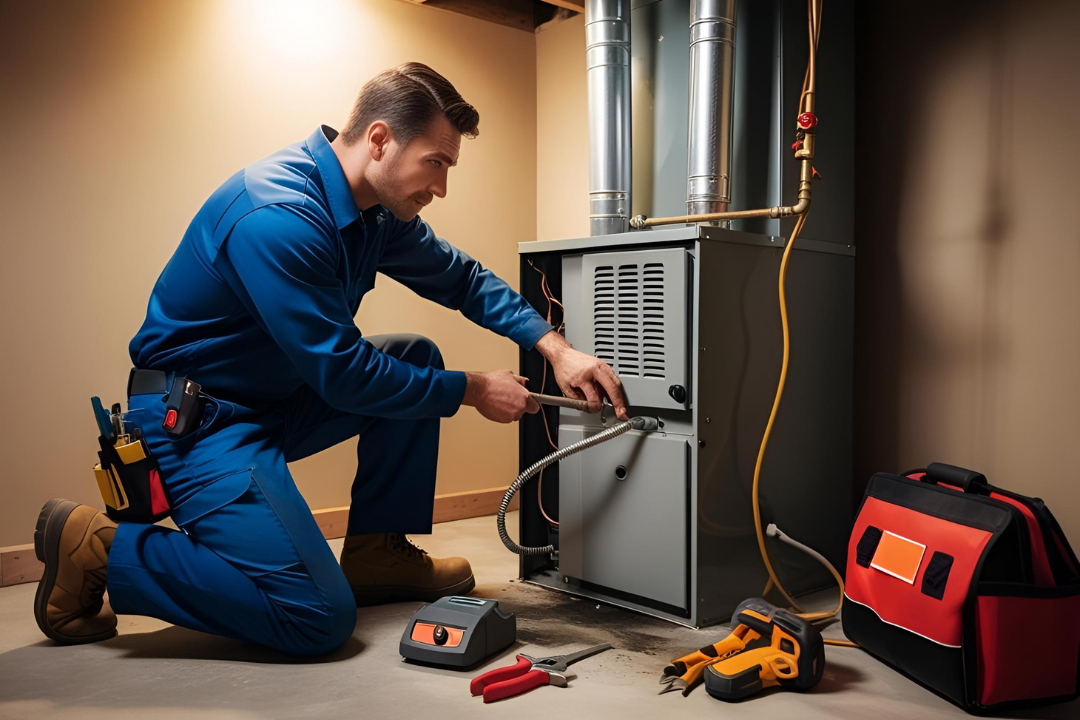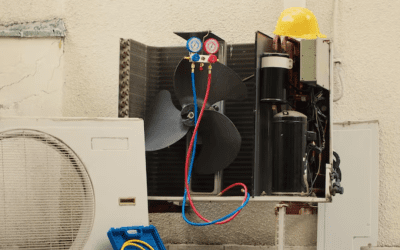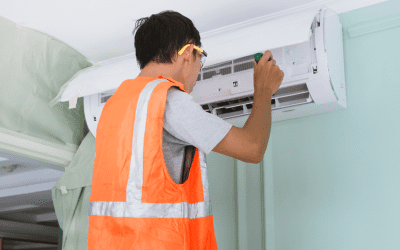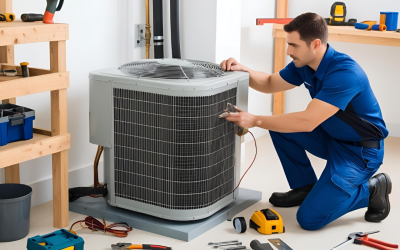Does your furnace pose a health and safety risk to your home? As the winter months drag on, it’s essential to make sure that your heating system is functioning appropriately. Particularly with gas furnaces, you can never be too careful with monitoring their daily performance. Homeowners have a right to be concerned about the quality of their air, as well as the overall safety of their family.
Carbon monoxide is the primary concern for homeowners with gas furnaces. As a natural part of the mechanisms of a furnace, carbon monoxide is produced. This dangerous chemical should remain contained inside of the heat exchanger, never entering into the indoor air of your home. The carbon monoxide should only exit the furnace through the flue pipe which ultimately pumps it outdoors. Understanding the common causes of leaks can help you focus on the most effective ways to prevent your furnace from leaking carbon monoxide.
However, small damages to the inside of the furnace could lead to leaks. Even a tiny crack in the right part of the furnace could mean major problems for your home. Carbon monoxide leaks almost always comes from cracked heat exchangers. These pieces are typically responsible for pumping the poisonous gas into the outdoor air, but a crack can render them ineffective.
Signs And Symptoms Of Carbon Monoxide Poisoning
Flu-Like Symptoms Without A Fever
Many of the symptoms of carbon monoxide poisoning, such as aches, fatigue, and headache, mimic those of the flu. However, CO poisoning does not cause a fever because it doesn’t trigger the body’s immune system in the same way a viral infection does.
Dizziness or Lightheadedness
Carbon monoxide decreases the amount of oxygen reaching the brain, which disrupts its normal function. The brain, in turn, signals the body to experience dizziness as a protective mechanism to indicate something is wrong with the body’s oxygen levels. This also affects the vestibular system, which controls balance, making you feel lightheaded.
Shortness of Breath During Normal Activities
As oxygen is unable to reach the lungs and tissues efficiently, your body compensates by increasing your breathing rate to try and get more oxygen. This results in shortness of breath, even during simple tasks like walking or sitting.
Chest Tightness or Pressure
The heart, which relies heavily on oxygen, struggles to pump blood efficiently during CO exposure. This leads to chest tightness, as the heart works harder to supply oxygenated blood to the body.
Blurred Vision
The eyes require a rich supply of oxygen to function properly, particularly for tasks such as focusing and processing visual information. When carbon monoxide reduces oxygen levels in the bloodstream, the eyes are one of the first organs to show signs of strain, resulting in blurred or impaired vision. This happens because the brain struggles to analyse visual signals without adequate oxygen.
Muscle Weakness
Muscle tissues depend heavily on oxygen to generate energy for movement. When carbon monoxide interferes with oxygen delivery to muscle cells, they are unable to function at full capacity, leading to weakness and fatigue. This can make even light activities feel like heavy exertion, as the muscles lack the fuel they need to perform.
Mental Confusion and Memory Issues
The brain consumes more oxygen than any other organ. With carbon monoxide poisoning, oxygen is displaced by CO in the bloodstream, which leads to cognitive impairments, memory problems, and confusion. This can feel like a mental fog that’s hard to shake.
Effective Ways To Prevent Carbon Monoxide Leaks From The Furnace
Properly Maintain Furnace Components
The key components of a furnace—such as the heat exchanger, blower motor, and gas valve—work together to ensure safe and efficient operation.
- A heat exchanger transfers heat from the burning gas to the air, and if it develops cracks or rust, carbon monoxide can escape into your home instead of being vented outside. Regular inspection for signs of wear, such as rust spots or cracks, helps identify potential issues early, preventing CO leaks.
- The blower motor, which circulates heated air throughout the home, can accumulate dust or debris over time. If the motor becomes clogged or fails to operate correctly, it may cause the furnace to overheat or malfunction, potentially increasing the risk of CO buildup. Cleaning and servicing the blower motor helps maintain its efficiency and prevents overheating that could damage the system.
- The gas valve regulates the flow of fuel to the burner. If the gas valve becomes faulty, it may cause the furnace to burn fuel improperly, resulting in an inefficient combustion process that can increase the production of carbon monoxide. Regular inspection and calibration of the gas valve ensure that the furnace burns fuel safely, reducing the chances of CO leaks.
Install A Carbon Monoxide Detector
Installing a carbon monoxide detector is one of the most effective ways to protect your home from unseen threats. These detectors monitor the air quality in your home and sound an alarm if CO levels rise to dangerous levels. By installing detectors near bedrooms and on each floor, you get early alerts, giving you time to ventilate or evacuate before harmful exposure occurs.
Ensure The Furnace Is Properly Sealed
If your furnace casing or heat exchanger has cracks or gaps, carbon monoxide can escape into the home. The furnace should be properly sealed to prevent leaks. Regularly inspect the unit for signs of wear, rust, or physical damage that may cause gaps in the seal. Sealing these gaps ensures that carbon monoxide remains confined to the exhaust system and is safely vented outdoors.
Hire A Licensed HVAC Professional
There are certain situations where hiring a licensed HVAC professional becomes essential. If your furnace begins producing unusual odors, inconsistent heat, strange noises, or causes your carbon monoxide detector to go off, these are immediate red flags. A licensed technician can diagnose complex issues like a cracked heat exchanger, improper combustion, or faulty venting—problems that aren’t always visible but can lead to dangerous carbon monoxide leaks.
If you need help, you can hire an expert from Classic Air Conditioning and Heating. We specialize in furnace repair, installation, and maintenance. Our skilled technicians are trained to identify and resolve issues that could lead to dangerous carbon monoxide leaks. With regular service, we improve your system’s efficiency, extend its lifespan, and ensure optimal indoor air quality. Trust us for reliable, thorough furnace care!
Wrapping Up
If you’ve followed the recommended steps but are still facing issues, it may be time to consider replacing your outdated furnace. If your furnace is over 15-20 years old, this risk only increases. Upgrading to a newer, more efficient model addresses potential safety hazards and comes with advanced features like built-in CO sensors. These modern units are designed to keep your home safer and more energy-efficient, reducing the chances of CO leaks and offering long-term savings.






